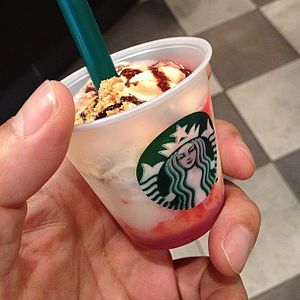
Starbucks – free food sample in 2013
As the fourth “P”, promotion and promotional tools are focused on raising customer / stakeholder awareness of a product or brand’s unique value; put in place a ‘call to action’; generate sales; create brand loyalty and satisfaction post-purchase. The promotional mix often includes direct (personal) selling; advertising (including the web), sales promotion, direct marketing, and publicity.
Promotional objectives include: showing consumers information about the product; increasing demand; and differentiating it from competitors’ offerings, by highlighting its differences and distinctiveness. The end-result can include: sales increases, new product acceptance, creation of brand equity, positioning, competitive retaliations, or creation of a corporate image.
Many organizations use promotions to generate excitement and interest in their products – with giveaways, competitions, advertising, sales, and more. For example, Starbucks frequently provides free samples of new product introductions, to generate sales, customer excitement, social sharing (of the images on the web) and customer feedback.
Examples of traditional media include print media such as newspapers and magazines, electronic media such as radio, TV, and outdoor media such as banner or billboard advertisements.
Guerilla marketing is a promotion and advertising strategy in which low-cost unconventional means (graffiti or street art, sticker bombing, flash mobs) are used, often locally, or with a larger network across cells / hubs to promote a product or an idea.
Digital marketing can take promotions to the next level: with search engine optimization (SEO) for desktops and mobile phones, search engine marketing (SEM), content and educational marketing, influencer marketing, content automation, campaign marketing, and e-commerce marketing, social media marketing, social media optimization, e-mail direct marketing, display advertising, e–books, optical disks and games, and other forms of digital media. It also extends to non-Internet channels that provide digital media, such as mobile phones (SMS and MMS), callback and on-hold mobile ring tones.
For every promotion, it is important to have a realistic picture of costs; a timeline for results and expected return on investment (ROI). Costs can include product samples, direct salaries, commissions (per unit), operations support (including public and media relations), campaign monitoring, evaluation and re-targeting.
Integrated marketing and communications harnesses all marketing and communications resources, activities, and tactics – in traditional, digital and blended formats – to ensure alignment, consistency, effectiveness, impact, and a greater return on investment (ROI).
The purpose of this learning pathway is to help you understand how promotion tools and techniques contribute to product marketing success and profitability. You will learn to:
- Explain product promotion and its characteristics.
- Identify the key elements of a promotional strategy for a product at different stages in its life cycle.
- Explain how guerrilla marketing can expand the reach and cost-effectiveness of a promotional campaign.
As the fourth “P”, promotion and promotional tools are focused on raising customer / stakeholder awareness of a product or brand’s unique value; put in place a ‘call to action’; generate sales; create brand loyalty and satisfaction post-purchase. The promotional mix often includes direct (personal) selling; advertising (including the web), sales promotion, direct marketing, and publicity.
Promotional objectives include: showing consumers information about the product; increasing demand; and differentiating it from competitors’ offerings, by highlighting its differences and distinctiveness. The end-result can include: sales increases, new product acceptance, creation of brand equity, positioning, competitive retaliations, or creation of a corporate image.
Many organizations use promotions to generate excitement and interest in their products – with giveaways, competitions, advertising, sales, and more. For example, Starbucks frequently provides free samples of new product introductions, to generate sales, customer excitement, social sharing (of the images on the web) and customer feedback.
Examples of traditional media include print media such as newspapers and magazines, electronic media such as radio, TV, and outdoor media such as banner or billboard advertisements.
Guerilla marketing is a promotion and advertising strategy in which low-cost unconventional means (graffiti or street art, sticker bombing, flash mobs) are used, often locally, or with a larger network across cells / hubs to promote a product or an idea.
Digital marketing can take promotions to the next level: with search engine optimization (SEO) for desktops and mobile phones, search engine marketing (SEM), content and educational marketing, influencer marketing, content automation, campaign marketing, and e-commerce marketing, social media marketing, social media optimization, e-mail direct marketing, display advertising, e–books, optical disks and games, and other forms of digital media. It also extends to non-Internet channels that provide digital media, such as mobile phones (SMS and MMS), callback and on-hold mobile ring tones.
For every promotion, it is important to have a realistic picture of costs; a timeline for results and expected return on investment (ROI). Costs can include product samples, direct salaries, commissions (per unit), operations support (including public and media relations), campaign monitoring, evaluation and re-targeting.
Integrated marketing and communications harnesses all marketing and communications resources, activities, and tactics – in traditional, digital and blended formats – to ensure alignment, consistency, effectiveness, impact, and a greater return on investment (ROI).
Objectives
The purpose of this learning pathway is to help you understand how promotion tools and techniques contribute to product marketing success and profitability. You will learn to:
Content is available under the
Creative Commons Attribution Share Alike License.
Privacy Policy | Authors